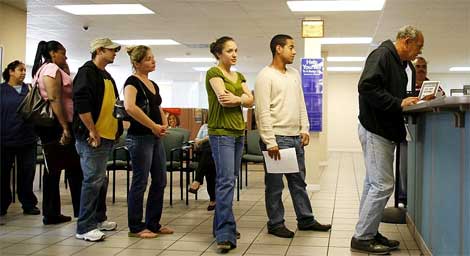
Slower job growth in February comes at a time when things need to be speeding up.
In the words of the legendary Dr. Ian Malcolm: Must go faster.
No, the crew here at the Alliance for American Manufacturing isn’t being chased by a terrifying T-rex. But we are looking at the just-released monthly jobs report, and the February numbers have us concerned.
Only 8,000 new manufacturing jobs were created in February. While it’s always good to see job growth, it’s a pretty big slowdown from previous months. In January, 21,000 new manufacturing jobs were created, while 28,000 were created in December and a whopping 89,000 were created in November.
Meanwhile, President Obama is more than halfway through his second term, but he still isn’t yet at the halfway mark of reaching his goal of creating 1 million new manufacturing jobs by the time he leaves office in January 2017. Just 383,000 new jobs have been created – leaving 617,000 to go. That leaves a lot of ground to make up.
Must go faster.
What’s slowing things down? For answers, we turn to the other big government data set that came out on Friday: the trade figures.
The monthly goods trade deficit with China reached $28.6 billion in January, while the deficit with Japan hit $5.7 billion. Trade deficits are bad for jobs here at home – the deficit with China cost 3.2 million jobs between 2001 and 2013, 2.4 million of which were in manufacturing. This is also bad for wages, as trade with China cost $37 billion in lost wages in 2011 alone.
Unchecked currency manipulation is one of the things driving the trade deficit, and it is also holding back significant job growth. Ending currency cheating by 20 countries – including China – would create 5.8 million new U.S. jobs in three years, according to a report from the Economic Policy Institute.
Unfortunately, it appears things could get worse before they get better. The potential foreign trade agreement known as the Trans-Pacific Partnership (TPP) would open up trade between the U.S. and 11 other Asia-Pacific nations, including Japan. But as it stands now, the TPP does not include an enforceable provision prohibiting countries from manipulating their currency.
If the TPP goes into effect as-is, manufacturing job growth is guaranteed to remain sluggish (if not head in the negative direction).
Tackling the trade deficit and stopping currency manipulation are perhaps the most important pieces of the job creation puzzle. But there are a few other things we can do to get things going, including investing in our infrastructure.
As Last Week Tonight with John Oliver so insightfully (and quite hilariously) pointed out this week, America’s infrastructure is in rough shape. America now ranks 16th in transportation infrastructure, making us less competitive on the international stage. More than one in five of our roads needs repair, while one in five of our bridges is structurally unsound.
On the jobs front, underinvestment in infrastructure has cost around 900,000 jobs. But more than 21,000 new jobs would be created for every $1 billion spent on infrastructure. A fully funded transportation infrastructure bill would create roughly 2.5 million new jobs.
There’s a lot left to do on the policy front to spur manufacturing job growth. What’s clear is that it is time to get serious, especially if we want to reach that 1 million number by 2017.
We simply must go faster.
